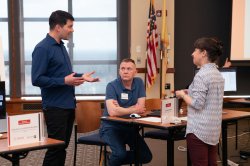Generally defined as the theory and practice of teaching, pedagogy refers to the methodology and process of how instructors approach teaching and learning using a specific curriculum with specific goals in mind. Traditional pedagogy refers predominantly to the face-to-face teaching environment and the conceptual frameworks around how people learn in that particular space. Over the past few decades, conventional pedagogy has evolved to include other modalities; specifically, the online environment. Most of the pedagogical practices used in the traditional face-to-face classroom can be applied effectively to other modes of teaching like an online, hybrid, or blended learning environments and vice-versa.
This section provides some pedagogical guidance and suggestions for instructors teaching in different learning environments. Regardless of the approach and learning space, effective pedagogical practices must be designed with the learner in mind in order to maximize engagement and ultimately, impact mastery of student outcomes. Instructional Technology and Design Services (ITDS) has compiled research and examples of sound pedagogical practices.
Please click on the name of the strategy to learn more about it. You can also use the entries on the left-hand menu.
| Name | Description |
|---|---|
|
Active Learning is a student-centered approach in which students engage in the learning process. Instructors are facilitators and students are encouraged to interact, engage and reflect. |
|
|
Authentic assessments measure student learning through real-world tasks or meaningful application of knowledge or skills. These typically take the form of a project or product of some sort. |
|
|
It is our responsibility as educators to empower ourselves with the information and experience necessary to properly field questions, acknowledge the potential benefits, uses and misuses of artificial intelligence tools, and understand how to leverage instructional design strategies and available technologies to both embrace the possibilities it offers while mitigating the abuse and misuse of artificial intelligence to shortcut student work. |
|
|
Teaching a compressed version of your course is an opportunity to thoughtfully repackage your content to accommodate the accelerated nature of this format. Accelerated courses require special attention to the distribution of work that results from combining content and activities previously spread across fifteen weeks. |
|
|
An ePortfolio is quite simply a website that enables students to compile digital evidence of their learning. Educators can use ePortfolios to gauge students’ development. |
|
|
Case-based teaching strategies use real-life examples to offer a shared learning experience. It may be difficult for students to experience real-world situations together. These scenarios, provide a common “experience” so that students can solve problems, make decisions, and generally think critically together. |
|
|
Flipping the classroom is an instructional strategy that leverages a blended learning model to achieve what the name implies: “flipping” the traditional classroom model. A flipped classroom is structured as the opposite, giving students their first exposure to coursework outside the classroom, often by reading or online video lectures. |
|
|
The first step to making meaningful strides towards diversity and inclusion in your course is making a commitment to evaluating your course and its content under a culturally aware lens and acknowledging the need to create a curriculum which fosters inclusion |
|
|
Mind mapping is a strategy that helps students visualize and analyze difficult concepts. Starting with a prompt or topic, students identify supporting themes or subtopics and illustrate connections using branches, color, images or other media. |
|
|
Addressing the unique needs of first-year students aids in facilitating their smooth and effective transition to satisfying the expectations and rigor of a higher education curriculum. Our undergraduate students join Montclair State from varied and diverse educational backgrounds and experiences in K-12. |
|
|
Teamwork and collaboration are active learning strategies in which students work and learn together in small groups to accomplish shared goals. Effective teamwork and collaboration are considered important to the students’ learning process. |
|
|
Universal Design for Learning (UDL) offers a set of principles to inform your approach to teaching. |
